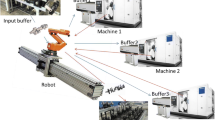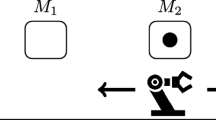Abstract
The typical production system in carton box production companies is cell-production. These cells normally benefit from a mobile robot which serves the machines according to a given schedule. One of the main problems of such companies is finding the order of robot moves in a way that the time required for completing all jobs is minimized. In the studied case in this research, each cell contains three machines of which, two or three of them might be activated for production process depending on the product type. These machines are equipped with a one-capacitated input and output buffer. Considering the fact that the machines are capable of performing any operation, the assignments of the jobs to them may have several alternatives. The one-capacitated buffers make the robot scheduling more complex as they act as extra stations to be served by the robot (contribute to exponential increase in job assignments permutation). This study aims to deal with this complexity and provide a decision-making toolbox for business owners to determine and employ the best robot moving schedule according to the characteristics of the problem. The mentioned approach significantly contributes to decision-maker’s effective time management and results in adopting a better production scheme for each production cycle. In line with this prospect, this research proposes a sequential part production matrix (SPPM) to determine feasible robot move strategies through which the best scheduling scheme is introduced for different problem configurations. Additionally, a metaheuristic algorithm is proposed to determine the best robot move strategy for cases with more active machines in a cell as manual determination of the robot move strategies becomes exhaustive in such cases.






Similar content being viewed by others
References
Batur GD, Karasan OE, Akturk MS (2012). Multiple part-type scheduling in flexible robotic cells. Int J Prod Econ 135(2), 726–740. https://doi.org/10.1016/j.ijpe.2011.10.006
Dawande M, Geismar HN, Sethi SP, Sriskandarajah C (2005) Sequencing and scheduling in robotic cells: recent developments. J Sched 8(5):387–426. https://doi.org/10.1007/s10951-005-2861-9
De Giovanni L, Pezzella F (2010) An improved genetic algorithm for the distributed and flexible job-shop scheduling problem. Eur J Oper Res 200(2):395–408. https://doi.org/10.1016/j.ejor.2009.01.008
Ghadiri Nejad M, Huseyin G, Vizvari B, Vatankhah Barenji R (2017) A mathematical model and simulated annealing algorithm for solving the cyclic scheduling problem of a flexible robotic cell. Adv Mech Eng. https://doi.org/10.1177/1687814017753912
Ghadiri Nejad M, Kovacs G, Vizvari B, Vatankhah Barenji R (2017) An optimization model for cyclic scheduling problem in flexible robotic cell. Int J Adv Manuf Technol. https://doi.org/10.1007/s00170-017-1470-z (in press)
Ghadirinejad M, Mosallaeipour S (2013) A new approach to optimize a flexible manufacturing cell. In: 1st international conference on new directions in business, management, finance and economics, p 38
Golabi M, Shavarani SM, Izbirak G (2017) An edge-based stochastic facility location problem in UAV-supported humanitarian relief logistics: a case study of Tehran earthquake. Nat Hazards. https://doi.org/10.1007/s11069-017-2832-4
Gultekin H, Karasan OE, Akturk MS (2009) Pure cycles in flexible robotic cells. Comput Oper Res 36(2):329–343. https://doi.org/10.1016/j.cor.2007.10.007
Kats V, Levner E (2009) A parametric algorithm for 2-cyclic robotic scheduling with interval processing times. IFAC Proc Vol 42(4):780–785. https://doi.org/10.3182/20090603-3-RU-2001.0090
Kousi N, Koukas S, Michalos G, Makris S, Chryssolouris G (2016) Service oriented architecture for dynamic scheduling of mobile robots for material supply. Procedia CIRP 55:18–22. https://doi.org/10.1016/j.procir.2016.09.014
Kousi N, Michalos G, Makris S, Chryssolouris G (2016). Short—term planning for part supply in assembly lines using mobile robots. Procedia CIRP 44:371–376. https://doi.org/10.1016/j.procir.2016.02.131
Levner E, Meyzin L, Werner F (2009) Hierarchical Scheduling of Mobile Robots in Production-Transportation Supply Chains. IFAC Proc Vol 42(4):786–791. https://doi.org/10.3182/20090603-3-RU-2001.0214
Michalos G, Kousi N, Makris S, Chryssolouris G (2016) Performance assessment of production systems with mobile robots. Proc CIRP 41:195–200. https://doi.org/10.1016/j.procir.2015.12.097
Mosallaeipour S (2012) Robot move scheduling in an FMC. Eastern Mediterranean University. http://hdl.handle.net/11129/1813. Accessed June 2012
Sethi SP, Sriskandarajah C, Sorger G, Blazewicz J, Kubiak W (1992) Sequencing of parts and robot moves in a robotic cell. Int J Flex Manuf Syst 4(3):331–358. https://doi.org/10.1007/BF01324886
Uruk Z, Gultekin H, Akturk MS (2013) Two-machine flowshop scheduling with flexible operations and controllable processing times. Comput Oper Res 40(2):639–653. https://doi.org/10.1016/j.cor.2012.09.001
Zeballos LJ, Quiroga OD, Henning GP (2010) A constraint programming model for the scheduling of flexible manufacturing systems with machine and tool limitations. Eng Appl Artif Intell 23(2):229–248. https://doi.org/10.1016/j.engappai.2009.07.002
Author information
Authors and Affiliations
Corresponding author
Rights and permissions
About this article
Cite this article
Mosallaeipour, S., Nejad, M.G., Shavarani, S.M. et al. Mobile robot scheduling for cycle time optimization in flow-shop cells, a case study. Prod. Eng. Res. Devel. 12, 83–94 (2018). https://doi.org/10.1007/s11740-017-0784-x
Received:
Accepted:
Published:
Issue Date:
DOI: https://doi.org/10.1007/s11740-017-0784-x




